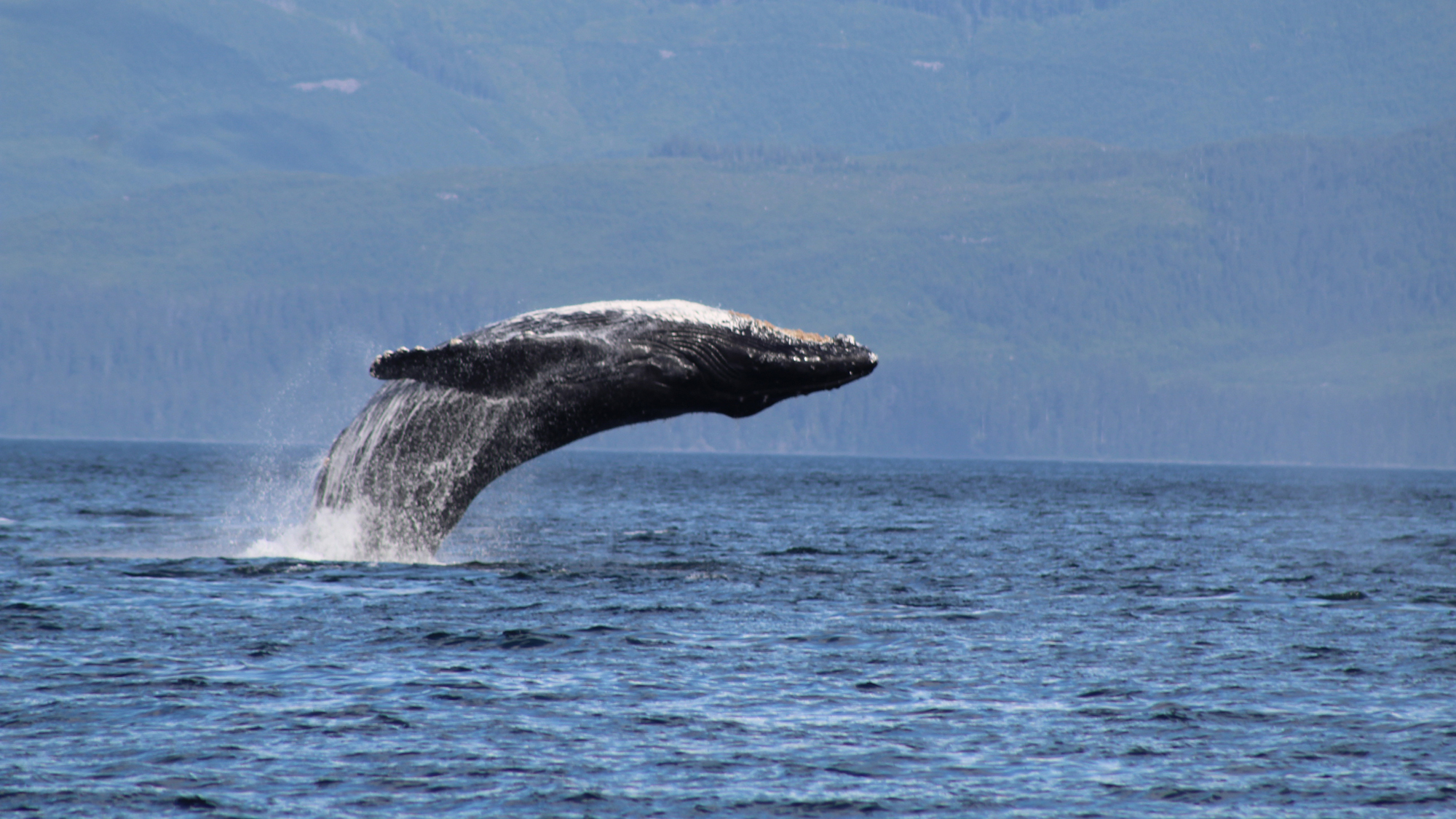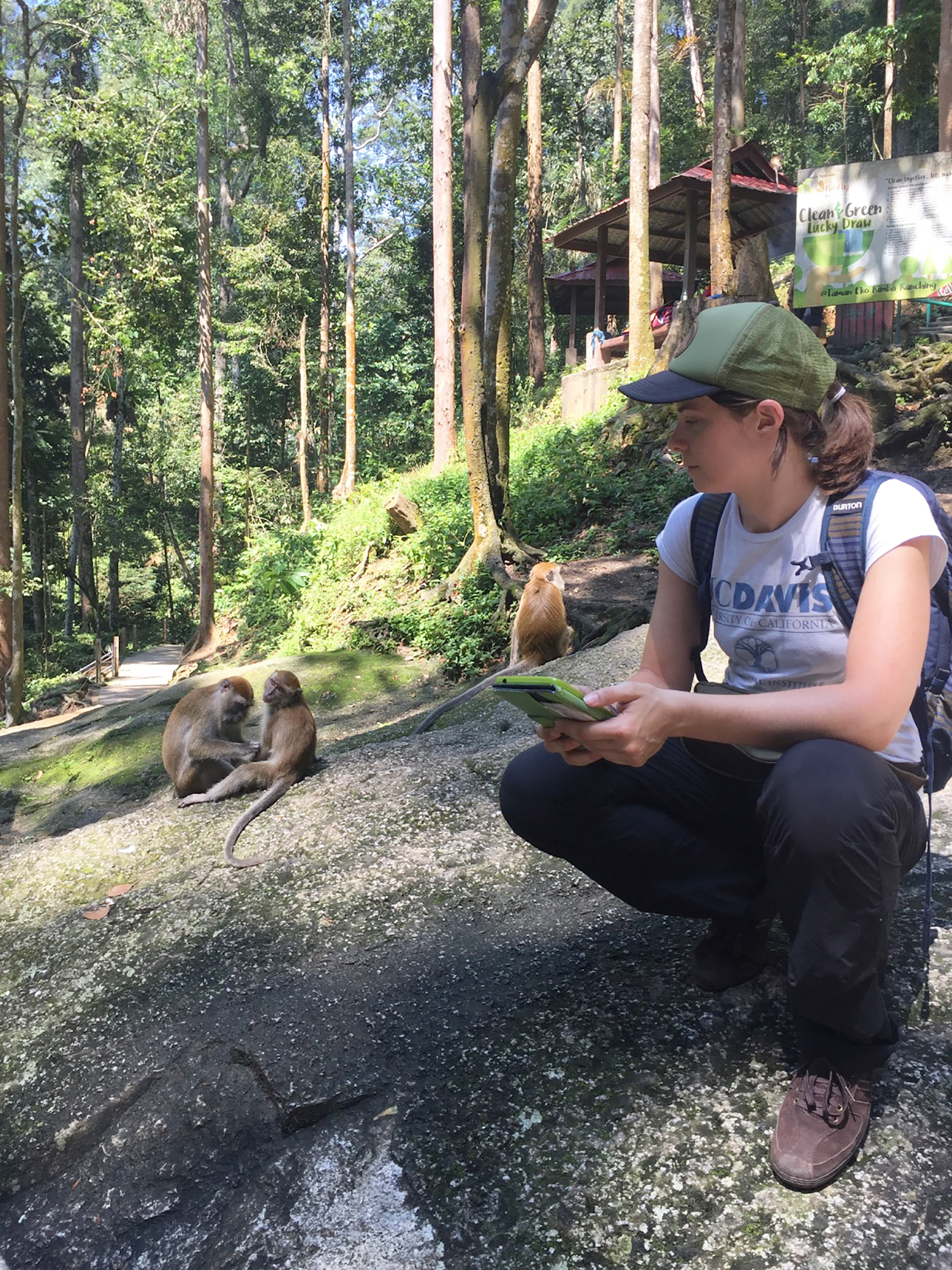
Exploring the Inner Lives of Primates, Birds and Whales
Postdoc Josephine Hubbard has followed the daily routines of lemurs, explored how macaques and birds solve problems, and even “conversed” with a whale
The day that Josephine Hubbard met Twain, she didn’t realize at first how unusual the encounter was.
Hubbard, who earned a Ph.D. in animal behavior in the College of Biological Sciences, is now a post-doctoral researcher at UC Davis. She is 33, five foot seven, has kind, serious eyes, and grew up in upstate New York. She’s animated as she describes the afternoon, three summers ago in Alaska, when she met Twain. Yes, it was a stilted conversation — that’s often the case when there’s a language barrier — but she’ll remember it for the rest of her life.
Twain is 41 or so. She is 50 feet long and weighs around 35 tons — a typical middle-aged humpback whale. A migratory creature, Twain splits her time between Alaska, British Columbia, and Hawaii, making the 2800-mile trek twice per year. She’s easy to identify because of the two patches of gleaming barnacles that stand out like glittery toenails on either tip of her tail.

On August 19, 2021, Hubbard stood on the top deck of the Glacier Seal, a research vessel, in Frederick Sound — a fjord flanked by mountains covered in conifer forests, 60 miles south of Juneau. Her job was to capture video of any whale approaching the vessel. During her week aboard the ship, she filmed a dozen or so other whales that passed near the boat – all of them brief encounters, like ships passing in the night. But Twain was different.
She circled the ship lazily for 20 minutes, pausing several times at the surface to breathe.
”It was overwhelming watching this enormous creature swim laps around our boat,” says Hubbard. But only later did the full implications become clear.
When Hubbard went below deck, she learned that the researchers down there had been playing and replaying a recorded whale call to Twain, giving the whale an opportunity to reply to each call. And for 20 minutes, Twain lingered there, responding to each one. The team had also played calls to each of the other whales that week – only Twain answered them.
Hubbard couldn’t hear those throaty whups rippling through the water — but as the team celebrated around her, the potential implications were breathtaking: “We matched her calls and she matched ours, which is pretty remarkable,” she says. “It suggests she was engaging in a conversation.”
Human linguists are picky about what they consider a true conversation – and Hubbard uses the term cautiously, with the mild caveat of implied quote marks. But she points out that Twain’s behavior, as well as her calls, suggested that it really was a back-and-forth communication of some sort.
Hubbard was helping with that project as a graduate student. Although she enjoyed her time with the whales, she’s spent most of her career working with primates. Currently she works at the California National Primate Research Center (CNPRC) under Melissa Bauman, a professor in the Department of Physiology and Membrane Biology, and director of the Women in Medicine and Health Sciences program in the UC Davis School of Medicine, with affiliations in the Center for Neuroscience, and the MIND Institute.
But the experience with Twain was a meaningful step in Hubbard’s long-term pursuit: studying the inner lives of animals, probing how they adapt to new challenges, how they form social networks, and how they make decisions when humans encroach.
“I absolutely love doing field research,” she says. “Whether it’s studying monkeys or birds or whales.”
From Madagascar to Malaysia

Hubbard grew up in a small ski town in the Catskill Mountains. Her dad did carpentry and taught skiing, while her mom waitressed and bartended.
Long hikes and camping trips with her father in the local forests imbued her with an interest in the natural world. After reading a book about jaguar research, she excitedly told her high school counselor that the wanted to be a field biologist; the counselor advised her to consider teaching or nursing instead.
It was a painful moment. Hubbard wondered whether the counselor was seeing her through the lens of gender roles. But she now looks back on it with more generosity. “I think she truly did not know that field biology was a job,” she says. “She was trying to give me the best advice she could.”
By the time Hubbard enrolled in State University of New York (SUNY) Stony Brook, she’d grown interested in ecology, animal behavior, and human impact on the natural world. Having grown up in a small, insular mountain town, she craved an opportunity to travel and expand her worldview. So she jumped at the chance to do a semester abroad in Madagascar.
Working under Patricia Wright, a prominent primatologist at Stony Brook, Hubbard spent 10 weeks in Ranomafana National Park — a fragment of intact rainforest that is still inhabited by lemurs. She spent long days in the forest, struggling to keep up with her guide as he bounded up and down the steep slopes, dodging through vines and undergrowth. After locating the lemurs, Hubbard spent hours documenting them as they swung and hopped through the crisscrossing branches overhead.
Comparing lemurs in two areas — one frequented by tourists, the other not — she found that lemurs near tourists spent more time traveling, moving frequently to avoid contact with the intruding humans. And perhaps because they were constantly on the move, they spent less time engaged in grooming and other social interactions. These effects were strongest when tourists approached the lemurs in large groups or startled them with flash photography.
By the end of that trip, Hubbard felt inspired by Dr. Wright’s role model as a woman in science; she realized that whatever her high school counselor might have implied, a career in field biology was not only possible, but potentially fulfilling.
After graduating with a dual degree in biology and anthropology in 2012, she worked as a field assistant on two other projects, studying capuchin monkeys in Costa Rica and bonobos in the Democratic Republic of Congo, before taking a laboratory assistant job with Brenda McCowan, a professor of ethology — that is, behavior — in the UC Davis School of Veterinary Medicine.
Working with McCowan at the CNPRC, she mapped out the development of infant macaque social networks— who they huddled with, and who they groomed. She also worked closely with a postdoc in the lab to profile bacterial DNA in macaque feces and found that gut bacteria travel from monkey to monkey through these same contacts. “It’s important,” she says, “because it could shed light on the way that social networks influence health and disease transmission.”

By 2017, Hubbard joined the animal behavior graduate group and began her Ph.D. under McCowan. In 2018, she visited Malaysia to study the problem-solving acumen of macaques at Templer Park, on the outskirts of Kuala Lumpur. Tourists flock to this lushly forested park to walk along a path past several waterfalls. Macaques gather from the surrounding forest, hoping to grab an unattended drink, or unzip a backpack stuffed with sandwiches.
Hubbard presented the thieving macaques with two food-getting problems. One was a clear plastic bottle filled with juice — a familiar task that all of the monkeys solved. The other problem was unfamiliar: a plexiglass box containing several peanuts that could be seen from the outside. Opening it required unfastening a set of latches.
She anticipated that macaques who interacted more frequently with humans and received more food handouts would solve this puzzle most easily. After all, they were probably better-nourished than their peers, since they could get more calorie-laden human food. But to Hubbard’s surprise, macaques who fed more on human food were less exploratory with these novel puzzles, suggesting that interaction with urban landscapes alters how macaques’ approach newly introduced objects into their environment.
Looking forward and giving back
Hubbard completed her Ph.D. in December of 2023, and began working with Bauman in January of 2024, studying how young macaques gain cognitive abilities and problem-solving flexibility as they mature.
She takes into that new job the broad experience gained while earning her Ph.D. During that time, she began writing stories about her work for lay readers, publishing them in The Ethogram, the official blog of the Animal Behavior Graduate Group. She co-chaired the group’s Diversity, Equity, and Inclusion (DEI) Committee, and helped establish a food pantry for grad students — a demographic well known for living on a shoestring budget.
As part of these DEI efforts, she helped develop online educational materials to guide prospective Ph.D. candidates through the process of applying to grad school. Mindful of her own beginnings, of being nudged away from her goal of becoming a scientist, she believes that getting into grad school depends on a lot more than simply earning a bachelor’s degree.
”There is a hidden curriculum in academia,” she says. “If you are first-generation and you don’t have a parent who knows how to apply to graduate school, it can be challenging.”
During graduate school, Hubbard also pursued opportunities to dabble in research outside the focus of her Ph.D. She helped on a project to study the problem-solving skills of great-tailed grackles. The goal was to understand whether these birds’ behavioral flexibility – that is, their ability to opportunistically eat insects, stolen French-fries, or many other foods, each collected in different ways – has helped them expand rapidly across urban areas in North America. The experiments found that grackles living in newly settled areas were more flexible in their approaches to finding food than those that had inhabited the same area for a long time.

And of course, Hubbard helped with the whales in Alaska. That project is co-led by McCowan, her former Ph.D. advisor, and by Laurance Doyle, an astrophysicist at the SETI Institute who is using mathematical analysis to detect complexity, grammar, and intelligence in non-human animals. The eventual hope is to apply their findings to the search for signals from intelligent life elsewhere in the universe.
Humpback whales are thought to have at least 50 distinguishable calls. The recorded “whup” that was repeatedly broadcast to Twain is thought to serve as a contact call — something along the lines of, “I’m here, is anyone else around?”
“The jury is still out on why Twain was so engaged,” says Hubbard. It could have been a conversation, or something more mundane, like excitement at hearing a familiar voice. After all, the broadcasted call had been recorded one day prior in a pod of whales where Twain was present. Or maybe for Twain it was something stranger: an awkward exchange with an odd visitor, who kept inexplicably repeating, “Hi, I’m here.”
But for Hubbard, it was transcendent — very different from monkeys or birds. “The whales are very stoic,” she says. “When they come up to breathe, it feels like an ancient experience.”
Media Resources
- Douglas Fox is a freelance science writer based in the Bay Area.
- theethogram.com
- Interactive bioacoustics playback as a tool for detecting and exploring nonhuman intelligence: “conversing” with an Alaskan humpback whale (PeerJ 2023)
- https://www.interspecies.io/lectures/conversing-with-whales
- Implementing a rapid geographic range expansion – the role of behavior changes (Peer Community Journal 2023)
- Affiliation and disease risk: social networks mediate gut microbial transmission among rhesus macaques (Animal Behavior 2019)
- Lemurs and tourism in Ranomafana National Park, Madagascar: economic boom and other consequences (Primate tourism: a tool for conservation 2014)
